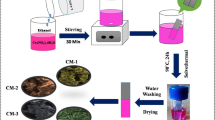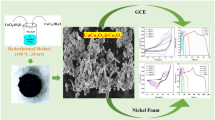Abstract
A three-dimensional (3D) structured electrode in which a compact CeO2-β-PbO2 particle layer on each carbon fiber in the felt (denoted as CF/CeO2-β-PbO2) was fabricated using cyclic voltammetry (CV) method in the presence of CeO2 nanoparticles in the electrolyte and supposed to be used as a sensor for in situ chemical oxygen demand (COD) detection. It was found that CeO2 was codeposited with PbO2 onto the anode, and the deposited crystals were tiny and compacted with each other. The electrochemical behaviors demonstrate that the fabricated CF/CeO2-β-PbO2 electrode possesses larger effective surface area, higher electrochemically catalytic activity, and better mechanical stability as compared with the anode without CeO2 deposited by CV method or constant potential (CP) method. The results of COD determination by the fabricated CF/CeO2-β-PbO2 electrode show a sensitivity of (3.0 ± 0.02) × 10−3 mA cm−2/mg L−1, a detection limit of 3.6 mg L−1 (S/N = 3) and a linear range of 30–8500 mg L−1 with correlation coefficient (R) of 0.9985 and RSD within 5 %.

A 3D CF/CeO2-β-PbO2 electrode with CeO2-β-PbO2 particle layer on each carbon fiber in the felt was supposed to be used as a sensor for in situ chemical oxygen demand (COD) detection. It was fabricated by cyclic voltammetry (CV) method in the presence of CeO2 nanoparticles in the electrolyte containing Pb2+. It was found that CeO2 was codeposited with PbO2 onto the anode and the deposited particles became tinier and more compact. The addition of CeO2 enhances the electrochemical catalytic activity. Tinier and more compact crystals enlarge the effective electrode area and improve the mechanical strength, which makes the CF/CeO2-β-PbO2 electrode possess higher detection sensitivity, wider linearity range, and longer service life in COD detection as compared with the anodes without CeO2 fabricated by CV method or constant potential (CP) method.













Similar content being viewed by others
References
Silvestre CIC, Frigerio C, Santos JLM, Lima JLFC (2011) Quantum dots assisted photocatalysis for the chemiluminometric determination of chemical oxygen demand using a single interface flow system. Anal Chim Acta 699:193–197
Gutiérrez-Capitán M, Baldi A, Gómez R, García V, Jiménez-Jorquera C, Fernández-Sánchez C (2015) Electrochemical nanocomposite-derived sensor for the analysis of chemical oxygen demand in urban wastewaters. Anal Chem 87:2152–2160
Orozco J, Fernández-Sánchez C, Mendoza E, Baeza M, Céspedes F, Jiménez-Jorquera C (2008) Composite planar electrode for sensing electrochemical oxygen demand. Anal Chem Acta 607:176–182
Zheng Q, Zhou BX, Bai J, Li LH, Jin ZJ, Zhang JL, Li JH, Liu YB, Cai WM, Zhu XY (2008) Self-organized TiO2 nanotube Array sensor for the determination of chemical oxygen demand. Adv Mater 20:1044–1049
Kim YC, Sasaki S, Yano K, Ikebukuro K, Hashimoto K, Karube I (2002) A flow method with photocatalytic oxidation of dissolved organic matter using a solid-phase (TiO2) reactor followed by amperometric detection of consumed oxygen. Anal Chem 74:3858–3864
Kondo T, Tamura Y, Hoshino M, Watanabe T, Aikawa T, Yuasa M, Einaga Y (2014) Direct determination of chemical oxygen demand by anodic decomposition of organic compounds at a diamond electrode. Anal Chem 86:8066–8072
Kim YC, Sasaki S, Yano K, Ikebukuro K, Hashimoto K, Karube I (2001) Photocatalytic sensor for the determination of chemical oxygen demand using flow injection analysis. Anal Chim Acta 432:59–66
Lee KH, Kim YC, Suzuki H, Ikebukuro K, Hashimoto K, Karube I (2000) Disposable chemical oxygen demand sensor using a microfabricated Clark-type oxygen electrode with a TiO2 suspension solution. Electroanal 12:1334–1338
Chen JS, Zhang JD, Xian YZ, Ying XY, Liu MC, Jin LT (2005) Preparation and application of TiO2 photocatalytic sensor for chemical oxygen demand determination in water research. Water Res 39:1340–1346
Kim YC, Lee KH, Sasaki S, Hashimoto K, Ikebukuro K, Karube I (2000) Photocatalytic sensor for chemical oxygen demand determination based on oxygen electrode. Anal Chem 72:3379–3382
Zhang JL, Zhou BX, Zheng Q, Li JH, Bai J, Liu YB, Cai WM (2009) Photoelectrocatalytic COD determination method using highly ordered TiO2 nanotube array. Water Res 43:1986–1992
Yuan SJ, Mao RY, Li YG, Zhang QH, Wang HZ (2012) Layer-by-layer assembling TiO2 film from anatase TiO2 sols as the photoelectrochemical sensor for the determination of chemical oxygen demand. Electrochim Acta 60:347–353
Yu HB, Wang H, Quan X, Chen S, Zhang YB (2007) Amperometric determination of chemical oxygen demand using boron-doped diamond (BDD) sensor. Electrochem Commun 9:2280–2285
Rössler-Fromme R, Scholz F (1996) A solid composite electrode for the determination of the electrochemical oxygen demand of aqueous samples. J Anal Chem 356:197–201
Li JQ, Li LP, Zheng L, Xian YZ, Jin LT (2006) Rh2O3/Ti electrode preparation using laser anneal and its application to the determination of chemical oxygen demand. Meas Sci Technol 17:1995–2000
Silva CR, Conceição CDC, Bonifácio VG, Filho OF, Teixeira MFS (2009) Determination of the chemical oxygen demand (COD) using a copper electrode: a clean alternative method. J Solid State Electrochem 13:665–669
Wang J, Li K, Yang C, Wang YL, Jia JP (2012) Ultrasound electrochemical determination of chemical oxygen demand using boron-doped diamond electrode. Electrochem Commun 18:51–54
Westbroek P, Temmerman E (2001) In line measurement of chemical oxygen demand by means of multipulse amperometry at a rotating Pt ring-Pt/PbO2 disc electrode. Anal Chim Acta 437:95–105
Ai SY, Gao MN, Yang Y, Li JQ, Jin LT (2004) Electrocatalytic sensor for the determination of chemical oxygen demand using a lead dioxide modified electrode. Electroanal 16:404–409
Li JQ, Li LP, Zheng L, Xian YZ, Ai SY, Jin LT (2005) Amperometric determination of chemical oxygen demand with flow injection analysis using F-PbO2 modified electrode. Anal Chim Acta 548:199–204
Chen JM, Xia YJ, Dai QZ (2015) Electrochemical degradation of chloramphenicol with a novel Al doped PbO2 electrode: performance, kinetics and degradation mechanism. Electrochim Acta 165:277–287
Li XH, Pletcherb D, Walsha FC (2011) Electrodeposited lead dioxide coatings. Chem Soc Rev 40:3879–3894
Mo HL, Tang Y, Wang XZ, Liu J, Kong DD, Chen YM, Wan PY, Cheng HN, Sun TQ, Zhang LY, Zhang M, Liu SY, Sun YZ, Wang N, Xing LX, Wang L, Jiang Y, Xu X, Zhang YY, Meng XD (2015) Development of a three-dimensional structured carbon fiber felt/β-PbO2 electrode and its application in chemical oxygen demand determination. Electrochim Acta 176:1100–1107
Kong JT, Shi SY, Kong LC, Zhu XP, Ni JR (2007) Preparation and characterization of PbO2 electrodes doped with different rare earth oxides. Electrochim Acta 53:2048–2054
Shmychkova O, Luk’yanenko T, Amadelli R, Velichenko A (2013) Electrodeposition of Ce-doped PbO2. J Electroanal Chem 706:86–92
Yao YW, Cui LH, Jiao LM, Chen X, Yu NC, Dong HS (2015) Effects of duty cycle on the preparation and property of PbO2-CeO2 nanocomposite electrodes. J Solid State Electrochem. doi:10.1007/s10008-015-3099-x
Rosestolato D, Amadelli R, Velichenko AB (2015) Electrode characteristics for ozone production: a case study using undoped and doped PbO2 on porous platinised titanium substrates. J Solid State Electrochem. doi:10.1007/s10008-015-2945-1
Hu X, Yu Y, Yang LJ (2015) Electrocatalytic activity of Ce-PbO2/C anode for acid red B reduction in aqueous solution. J Solid State Electrochem 19:1599–1609
Ai SY, Gao MN, Zhang W, Wang QJ, Xie YF, Jin LT (2004) Preparation of Ce-PbO2 modified electrode and its application in detection of anilines. Talanta 62:445–450
Zhang W, Xie YF, Gu J, Ai SY, Wang J, Yamamotod K, Jin LT (2004) Liquid chromatography with amperometric detection at a nano crystalline Ce-doped lead dioxide film modified electrode for determination of (R)-Salsolinol, (R)-N-methylsalsolinol and monoamine neurotransmitters in Parkinsonian patients’ cerebrospinal fluid. Analyst 129:229–234
Norouzi P, Garakani TM, Ganjali MR (2012) Using fast Fourier transformation continuous cyclic voltammetry method for new electrodeposition of nano-structured lead dioxide. Electrochim Acta 77:97–103
Yao YW, Zhao CM, Zhu J (2012) Preparation and characterization of PbO2-ZrO2 nanocomposite electrodes. Electrochim Acta 69:146–151
Yao YW, Li Y, Cui LH, Yu NC, Dong HS (2015) Preparation and photoelectrochemical property of PbO2-TiO2 nanocomposite electrodes. J Electrochem Soc 162:E7–E12
Yao YW, Zhou T, Zhao CM, Jing QM, Wang Y (2013) Influence of ZrO2 particles on fluorine-doped lead dioxide electrodeposition process from nitrate bath. Electrochim Acta 99:225–229
Abyaneh MY, Saez V, González-García J, Mason TJ (2010) Electrocrystallization of lead dioxide: analysis of the early stages of nucleation and growth. Electrochim Acta 55:3572–3579
Mook WT, Aroua MK, Chakrabarti MH, Low CTJ, Aravind PV, Brandon NP (2013) The application of nano-crystalline PbO2 as an anode for the simultaneous bio-electrochemical denitrification and organic matter removal in an up-flow undivided reactor. Electrochim Acta 94:327–335
Sirés I, Low CTJ, Ponce-de-León C, Walsh FC (2010) The deposition of nanostructured β-PbO2 coatings from aqueous methanesulfonic acid for the electrochemical oxidation of organic pollutants. Electrochem Commun 12:70–74
Labiadh L, Barbucci A, Cerisola G, Gadri A, Ammar S, Panizza M (2015) Role of anode material on the electrochemical oxidation of methyl orange. J Solid State Electrochem 19:3177–3183
Yao YW, Jiao LM, Yu NC, Guo F, Chen X (2016) Comparison of electrocatalytic characterization of Ti/Sb-SnO2 and Ti/F-PbO2 electrodes. J Solid State Electrochem 20:353–359
Zhu HB, Wang L, Chen YM, Li GY, Li H, Tang Y, Wan PY (2014) Electrochemical depolymerization of lignin into renewable aromatic compounds in a non-diaphragm electrolytic cell. RSC Adv 56:29917–29924
Ghorai TK, Biswas SK, Pramanik P (2008) Photooxidation of different organic dyes (RB, MO, TB, and BG) using Fe(III)-doped TiO2 nanophotocatalyst prepared by novel chemical method. Appl Surf Sci 254:7498–7504
Nezamzadeh-Ejhieh A, Moazzeni N (2013) Sunlight photodecolorization of a mixture of methyl Orange and bromocresol green by CuS incorporated in a clinoptilolite zeolite as a heterogeneous catalyst. J Ind Eng Chem 19:1433–1442
Chen T, Huang H, Ma HY, Kong DL (2013) Effects of surface morphology of nanostructured PbO2 thin films on their electrochemical properties. Electrochim Acta 88:79–85
Yao YW, Zhao MM, Zhao CM, Ma L (2014) Influence of duty cycle on the structure and electrocatalytic properties of pulse electrodeposited lead dioxide electrodes. J Solid State Electrochem 18:721–727
Darabizad G, Rahmanifar MS, Mousavi MF, Pendashteh A (2015) Electrodeposition of morphology- and size-tuned PbO2 nanostructures in the presence of PVP and their electrochemical studies. Mater Chem Phys 156:121–128
Li MC, Shen JN (2006) Photoelectrochemical oxidation behavior of organic substances on TiO2 thin-film electrodes. J Solid State Electrochem 10:980–986
Lubenov L, Bojinov M, Tzvetkoff T (2007) Oxidation of toluene on Bi-doped PbO2 studied by electrochemical impedance spectroscopy and UV spectrophotometry. J Solid State Electrochem 11:1613–1620
Long GL, Winefordner JD (1983) Limit of detection-a closer look at the IUPAC definition. Anal Chem 55:712A–724A
Poll CG, Payne DJ (2015) Electrochemical synthesis of PbO2, Pb3O4 and PbO films on a transparent conducting substrate. Electrochim Acta 156:283–288
Muhamed Ashraf P, Shibli SMA (2008) Development of CeO2- and TiO2-incorporated aluminium metal-composite matrix with high resistance to corrosion and biofouling. J Solid State Electrochem 12:315–322
Acknowledgments
The authors gratefully acknowledge the financial support by the National Natural Science Foundation of China (No. 51374016), the Fundamental Research Funds for the Central Universities of China (Nos. YS1406, JD1415, JD1515), BUCT Fund for Disciplines Construction and Development (No. XK1531), and the Fundamental Research Funds for the Central Universities (No. JD1515). This work is supported by the Beijing Key Laboratory of Environmentally Harmful Chemical Analysis. The authors especially thank Prof. Xiaoguang Liu for the important discussions and suggestions of this Work.
Author information
Authors and Affiliations
Corresponding authors
Electronic Supplementary Material
ESM 1
(DOC 57294 kb)
Rights and permissions
About this article
Cite this article
Mo, H., Tang, Y., Wang, N. et al. Performance improvement in chemical oxygen demand determination using carbon fiber felt/CeO2-β-PbO2 electrode deposited by cyclic voltammetry method. J Solid State Electrochem 20, 2179–2189 (2016). https://doi.org/10.1007/s10008-016-3207-6
Received:
Revised:
Accepted:
Published:
Issue Date:
DOI: https://doi.org/10.1007/s10008-016-3207-6




